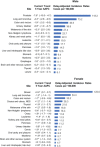Annual Report to the Nation on the Status of Cancer, part I: National cancer statistics
- PMID: 29786848
- PMCID: PMC6033186
- DOI: 10.1002/cncr.31551
Annual Report to the Nation on the Status of Cancer, part I: National cancer statistics
Abstract
Background: The American Cancer Society (ACS), the Centers for Disease Control and Prevention (CDC), the National Cancer Institute (NCI), and the North American Association of Central Cancer Registries (NAACCR) collaborate to provide annual updates on cancer occurrence and trends in the United States.
Methods: Incidence data were obtained from the CDC-funded and NCI-funded population-based cancer registry programs and compiled by NAACCR. Data on cancer deaths were obtained from the National Center for Health Statistics National Vital Statistics System. Trends in age-standardized incidence and death rates for all cancers combined and for the leading cancer types by sex, race, and ethnicity were estimated by joinpoint analysis and expressed as the annual percent change. Stage distribution and 5-year survival by stage at diagnosis were calculated for breast cancer, colon and rectum (colorectal) cancer, lung and bronchus cancer, and melanoma of the skin.
Results: Overall cancer incidence rates from 2008 to 2014 decreased by 2.2% per year among men but were stable among women. Overall cancer death rates from 1999 to 2015 decreased by 1.8% per year among men and by 1.4% per year among women. Among men, incidence rates during the most recent 5-year period (2010-2014) decreased for 7 of the 17 most common cancer types, and death rates (2011-2015) decreased for 11 of the 18 most common types. Among women, incidence rates declined for 7 of the 18 most common cancers, and death rates declined for 14 of the 20 most common cancers. Death rates decreased for cancer sites, including lung and bronchus (men and women), colorectal (men and women), female breast, and prostate. Death rates increased for cancers of the liver (men and women); pancreas (men and women); brain and other nervous system (men and women); oral cavity and pharynx (men only); soft tissue, including heart (men only); nonmelanoma skin (men only); and uterus. Incidence and death rates were higher among men than among women for all racial and ethnic groups. For all cancer sites combined, black men and white women had the highest incidence rates compared with other racial groups, and black men and black women had the highest death rates compared with other racial groups. Non-Hispanic men and women had higher incidence and mortality rates than those of Hispanic ethnicity. Five-year survival for cases diagnosed from 2007 through 2013 ranged from 100% (stage I) to 26.5% (stage IV) for female breast cancer, from 88.1% (stage I) to 12.6% (stage IV) for colorectal cancer, from 55.1% (stage I) to 4.2% (stage IV) for lung and bronchus cancer, and from 99.5% (stage I) to 16% (stage IV) for melanoma of the skin. Among children, overall cancer incidence rates increased by 0.8% per year from 2010 to 2014, and overall cancer death rates decreased by 1.5% per year from 2011 to 2015.
Conclusions: For all cancer sites combined, cancer incidence rates decreased among men but were stable among women. Overall, there continue to be significant declines in cancer death rates among both men and women. Differences in rates and trends by race and ethnic group remain. Progress in reducing cancer mortality has not occurred for all sites. Examining stage distribution and 5-year survival by stage highlights the potential benefits associated with early detection and treatment. Cancer 2018;124:2785-2800. © 2018 American Cancer Society.
Keywords: Annual Report to the Nation; Epidemiology; National Program of Cancer Registries (NPCR); National Vital Statistics System (NVSS); North American Association of Central Cancer Registries (NAACCR); Surveillance; and End Results (SEER); cancer; incidence; mortality; survival; trends.
© 2018 The Authors. Cancer published by Wiley Periodicals, Inc. on behalf of American Cancer Society.
Figures




Comment in
-
Re: Annual Report to the Nation on the Status of Cancer, Part I: National Cancer Statistics.J Urol. 2020 Sep;204(3):618. doi: 10.1097/JU.0000000000001175.02. Epub 2020 Jun 30. J Urol. 2020. PMID: 32603206 No abstract available.
References
-
- Wingo PA, Ries LA, Rosenberg HM, Miller DS, Edwards BK. Cancer incidence and mortality, 1973‐1995: a report card for the United States. Cancer. 1998;82:1197‐1207. - PubMed
-
- Wingo PA, Ries LA, Giovino GA, et al. Annual report to the nation on the status of cancer, 1973‐1996, with a special section on lung cancer and tobacco smoking. J Natl Cancer Inst. 1999;91:675‐690. - PubMed
-
- Ries LA, Wingo PA, Miller DS, et al. The annual report to the nation on the status of cancer, 1973‐1997, with a special section on colorectal cancer. Cancer. 2000;88:2398‐2424. - PubMed
-
- Howe HL, Wingo PA, Thun MJ, et al. Annual report to the nation on the status of cancer (1973 through 1998), featuring cancers with recent increasing trends. J Natl Cancer Inst. 2001;93:824‐842. - PubMed
-
- Edwards BK, Howe HL, Ries LA, et al. Annual report to the nation on the status of cancer, 1973‐1999, featuring implications of age and aging on US cancer burden. Cancer. 2002;94:2766‐2792. - PubMed
Publication types
MeSH terms
LinkOut - more resources
Full Text Sources
Other Literature Sources
Medical

